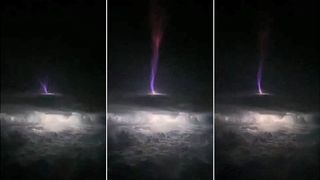'Gigantic jet' that shot into space may be the most powerful lightning bolt ever detected
This lightning bolt over Oklahoma was one of the rarest and most powerful on Earth.

The sky turns dark, a heavy rain falls and a bolt of lightning crackles through the air. But instead of striking down toward the ground, or zipping sideways between clouds, this lightning bolt does something unexpected: It blasts straight upward from the top of the cloud, shooting 50 miles (80 kilometers) into the sky, grazing the lower edge of space.
Bolts like these are called gigantic jets. They are the rarest and most powerful sort of lightning, occurring as few as 1,000 times a year and emitting more than 50 times as much energy as a typical lightning bolt — and now, scientists have just detected the single most powerful gigantic jet yet.
In a study published Aug. 3 in the journal Science Advances, researchers analyzed a gigantic jet that shot out of a cloud over Oklahoma in 2018. By studying the jet's radio-wave emissions using satellite and radar data, the team learned that the bolt moved approximately 300 coulombs of energy from the top of the cloud to the lower ionosphere — the layer of charged particles that separates Earth's upper atmosphere from the vacuum of space — or roughly 60 times the 5-coulomb output of a typical lightning bolt.
"The charge transfer is nearly double the previous largest by a gigantic jet and is comparable to the largest ever recorded for cloud-to-ground strokes," the researchers wrote in the study.
Related: What's the longest lightning bolt ever recorded?
Capturing such detailed data on the massive stroke of lightning required an equally massive stroke of luck. A citizen scientist based in Hawley, Texas filmed the jet with a low-light camera on May 14, 2018, watching as the gargantuan discharge shot out of a cloud top before connecting with charged particles in the ionosphere, some 60 miles (96 km) above the ground.
Scientists analyzing the footage found that, as luck would have it, the jet occurred very near the center of a large lightning mapping array (LMA) — a network of ground-based radio antennas used to map the locations and times of lightning strikes. The jet was also within range of several weather radar systems, as well as a weather-watching satellite network.
Get the Space.com Newsletter
Breaking space news, the latest updates on rocket launches, skywatching events and more!
With these sources combined, the researchers studied the size, shape and energy output of the gigantic jet in unprecedented detail. The researchers found that the jet's highest-frequency radio-wave emissions (the kind that LMAs are built to detect) came from small structures called streamers, which develop at the very tip of a lightning bolt and create a "direct electrical connection between the cloud top and the lower ionosphere," lead study author Levi Boggs, a research scientist at the Georgia Tech Research Institute, said in a statement.
The strongest electric current, meanwhile, flowed considerably behind the streamers, in a section called the leader. The data also showed that while the streamers were relatively cool, with a temperature of roughly 400 degrees Fahrenheit (204 degrees Celsius), the leader was scorching hot, with a temperature of more than 8,000 degrees F (4,426 C). This discrepancy is true of all lightning strikes, not just gigantic jets, the researchers wrote.
So, why does lightning sometimes blast up instead of down? Scientists still aren't totally clear on that, but it likely involves some sort of blockage that prevents lightning from escaping through the bottom of a cloud; gigantic jets are typically observed in storms that don't produce many cloud-to-ground lightning strikes, the team added.
For whatever reason, there is usually a suppression of cloud-to-ground discharges," Boggs said. "In the absence of the lightning discharges we normally see, the gigantic jet may relieve the buildup of excess negative charge in the cloud."
Gigantic jets are also reported most frequently in tropical regions, the team noted. This makes the record-breaking jet over Oklahoma all the more remarkable; the jet was not part of a tropical storm system. More research — and a lot more luck — is needed to understand these epic, upside-down lightning strikes.
Originally published on Live Science.
Join our Space Forums to keep talking space on the latest missions, night sky and more! And if you have a news tip, correction or comment, let us know at: community@space.com.

Brandon has been a senior writer at Live Science since 2017, and was formerly a staff writer and editor at Reader's Digest magazine. His writing has appeared in The Washington Post, CBS.com, the Richard Dawkins Foundation website and other outlets. He holds a bachelor's degree in creative writing from the University of Arizona, with minors in journalism and media arts. He enjoys writing most about space, geoscience and the mysteries of the universe.

